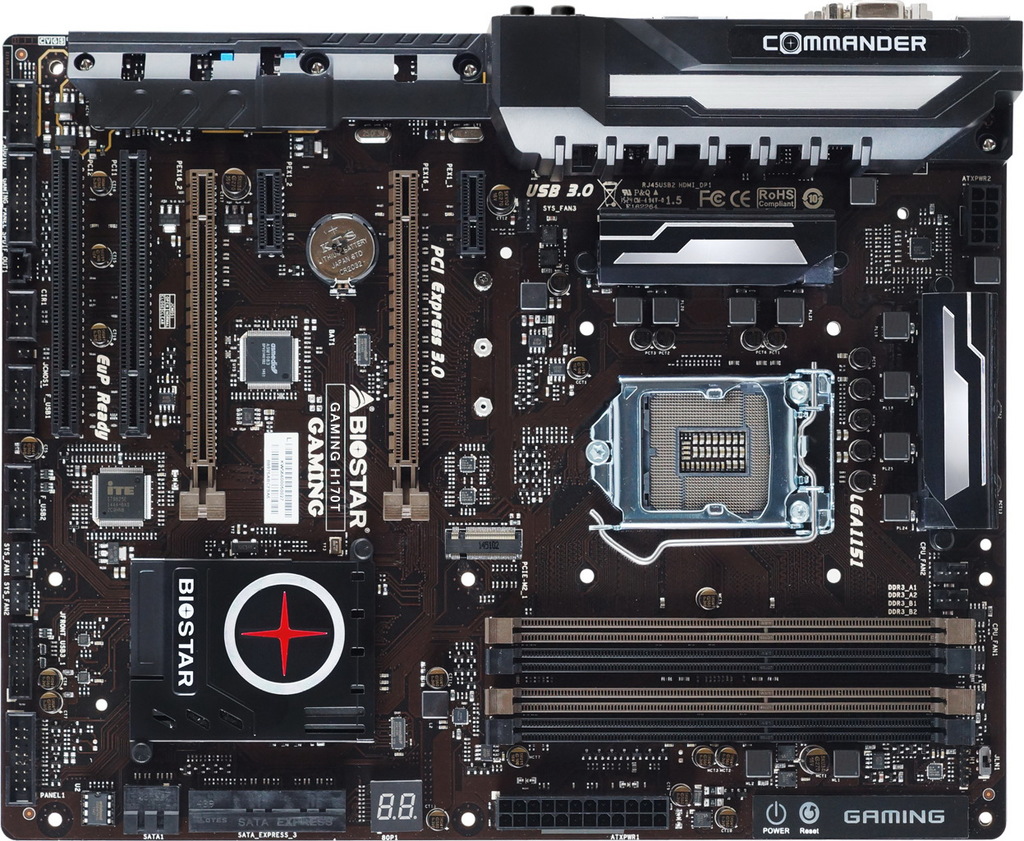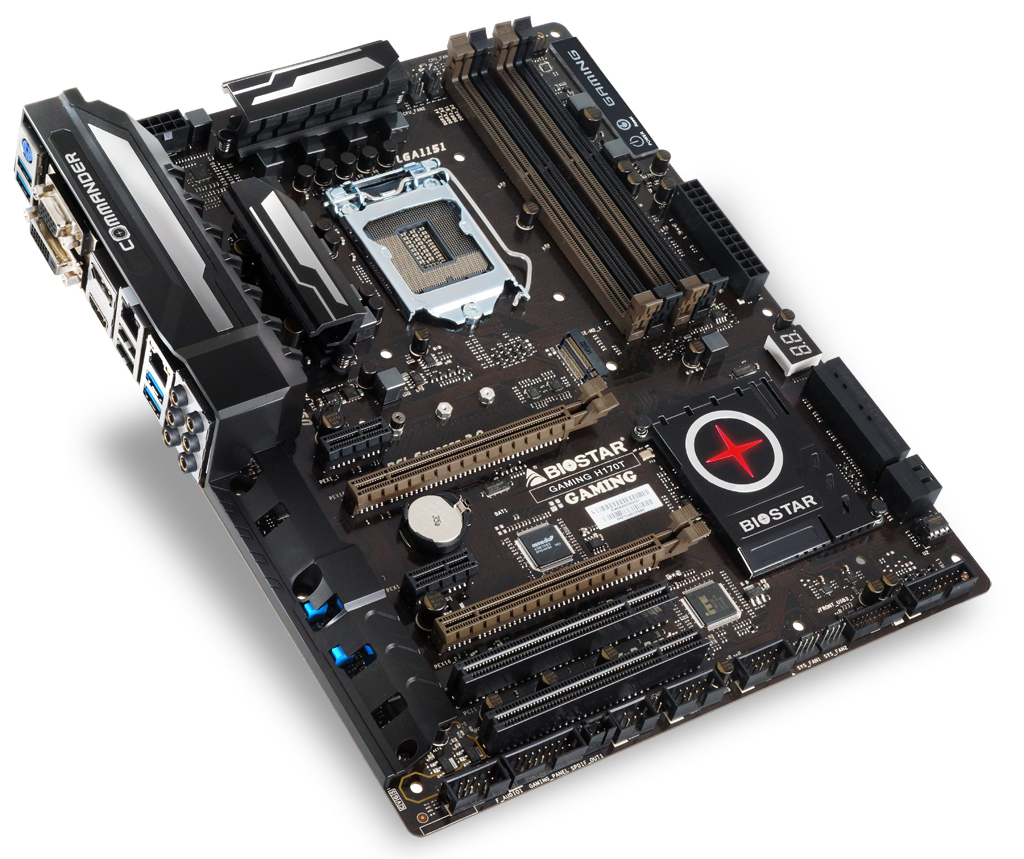ASRock, Biostar, Gigabyte, MSI H170 Motherboard Round-Up
Why you can trust Tom's Hardware
Biostar Gaming H170T
Biostar's Gaming H170T ATX board looks nice, but we'll see if judging this book by its cover makes sense. It appears to possess eight VRM phases, based on the number of exposed chokes and eight visible control ICs under the board, but the VRMs themselves are covered by heat sinks.
The codec is the ALC892, an upper-mainstream part, with 90dB S/N on the input, and 97dB S/N on the output. It isn't professional quality, but most users should find it satisfactory. One thing I found irritating is that the six audio jacks on the backplate are not color-coded, but are all black, so you'll need to refer to the manual at least once to know which is which.



In the box, you get the board, driver CD and an 8 1/4 x 5 13/16-inch, staple-bound manual, which does not lie flat. It covers this board, and also the B150T and Z170T Gaming boards. Languages include English, German, Chinese, Spanish, Thai, Russian and Arabic.
Accessories include four SATA cables (finally!), the I/O plate and a small bag with three screws. Although I did not initially find an obvious use for them, a reading of the manual suggests they might be used to mount an optional Gaming Commander front panel, which was not included with the review sample. Port and fan headers are all around edges in typical locations, except for one fan header to the right of the first PCIe X1 connector. There is a two-digit diagnostic display between the SATA and SATA Express connectors in the left front, and the ATX power connector just right of middle.
On the other side of the power connector is an illuminated panel with power and reset touch switches. This panel glows red when the board is receiving +5VSB power. To the left of the CPU socket, below the first PCIe slot, is the M.2 slot. Two SATA ports are disabled if you use the M.2 slot with a PCIe drive, and a single, different SATA port is disabled if you use it with a SATA drive. The only obstruction on the board is the lithium coin battery, which will be occluded by a double-slot graphics card in the PCIe 3.0 X16 slot.
Above those are the four DIMM slots, and here was my first surprise; they are DDR3L, not DDR4. Fortunately, I had some DDR3L on hand, so my testing could proceed.
My second surprise is that I was unable to obtain BIOS screen shots; the board locked up at any attempt I made, using a known good USB thumb drive, which was otherwise correctly recognized by the BIOS.
Get Tom's Hardware's best news and in-depth reviews, straight to your inbox.
The third surprise concerned the included Toverclocker utility. When I started looking at H170 boards, rumors swirled over which of them might allow BCLK overclocking, and this looked to be one of them. I incrementally ran the built-in test on BCLK up to 120 and obtained rapid "success" messages, before actually attempting a 105 BCLK. Essentially, nothing happened. The utility said it was applying the change, but after an extended period of time, it never came back. Windows never crashed, and the utility itself could be closed, but it simply didn't work. I even returned to this board, after testing three of the others, to see if maybe there was a BIOS update to fix this as well as the screenshot lockup problem. Nope, the shipping BIOS is the only one.
I have to wonder, if BIOS changes were rushed through to deal with Intel's concerns about BCLK overclocking, that could account for these issues. I don't think either of them seriously affects the utility of this board, however. Still, after being pleasantly surprised by a Biostar B85 board I wrote up some time ago, I was a little disappointed in this one. The potential is there, but it appears to need some polish. So, what else might Biostar have up its sleeve?
Current page: Biostar Gaming H170T
Prev Page Introduction And Specifications Next Page Biostar Hi-Fi H170Z3-
SpAwNtoHell 1. Valid for who upgrades their system from older platform and have already win 8.1 bought not relevant for who upgrades to win 10 or buying a new win10...Reply
2. H170 supposed to be cheaper is not entirely true... So myself i do not see the point paying for a cut chipset not less or almost no difference compared to z170... As this is inteded for budget build... -
Onus Thanks to Kasia for some quick fixes in the text.Reply
Otherwise, I take full blame (or credit) for the results! These are decent boards for most people. -
Snipergod87 Do people buy BioStar products? I have never seen them used in PCPartPicker builds or really recommended on the forums.Reply
Also I don't see why a lack of SATA-Express is a problem on the ASRock board as there are no devices to utilize it. -
turkey3_scratch Reply17750886 said:Do people buy BioStar products? I have never seen them used in PCPartPicker builds or really recommended on the forums.
Also I don't see why a lack of SATA-Express is a problem on the ASRock board as there are no devices to utilize it.
Not really, they're considered to be not as reliable, just like EVGA boards. Though there is no factual data I can think of to back up this claim, it is general consensus. -
Onus Reply
Exactly. I think they're still recovering from some bad S775 and AM2 boards they put out (I got some myself) some years ago. Their latest boards that I've seen have used the same quality caps and chokes as the Big Boys, and the boards are similarly well-made and don't feel cheap. A few minor BIOS glitches don't explain it; ASRock has had those too, as has MSI, and ASRock has also put out some really thin boards (with otherwise decent components), but they've had no serious call-outs for it. Biostar probably needs to determine whether or not their marketing and sales droids have been doing their jobs.17750935 said:17750886 said:Do people buy BioStar products? I have never seen them used in PCPartPicker builds or really recommended on the forums.
Also I don't see why a lack of SATA-Express is a problem on the ASRock board as there are no devices to utilize it.
Not really, they're considered to be not as reliable, just like EVGA boards. Though there is no factual data I can think of to back up this claim, it is general consensus.
-
jtd871 I'm pleased that you reviewed a H170 mITX mobo. But I don't know why you list 1) "Limited expandability due to size" and 2) "M.2 is only PCIe" as cons for the MSI board.Reply
1) People buying a mini-ITX board don't want (or expect) much, if any, expandability. Limited expandability is arguably the whole point of mITX.
2) The only compelling reason to go with an M.2 interface is to use a (PCIe x4) NVMe SSD. If the M.2 interface *wasn't* PCIe, only then it should be called out as a con. -
Onus Yes, point #1 is self-evident, but it is fair to point out, as it is a sufficient con that many people will not be able to go with a mini-ITX build. Although there are many USB3.0 peripherals available, a builder who already has a PCI video capture card, or a PCIe wireless NIC, may not wish to re-buy USB versions. I will disagree about point #2 on the basis of all the other boards' M.2 interfaces working with both card types. Someone building new would likely insist upon PCIe for the M.2 slot (as you say), but someone moving a drive, even if he plans a future upgrade, initially needs mSATA as well. To be fair, a slot that can only take a mSATA drive would also be listed as a con.Reply
As always, a given Pro or Con may not apply to you, so it might not affect your decision at all. If it does apply, it could be a dealbreaker to some.
-
80-watt Hamster Reply17750886 said:Do people buy BioStar products? I have never seen them used in PCPartPicker builds or really recommended on the forums.
Also I don't see why a lack of SATA-Express is a problem on the ASRock board as there are no devices to utilize it.
I had a Biostar 754 board back in the day. Never gave me a bit of trouble, though I didn't exactly push it particularly hard. It powered the last iteration of my Linux box (still have the drive with the /home partition, swear I'll resurrect it... someday), and was in service for probably 4-5 years. In fact, I think it's hanging out in a box destined for electronics recycling, and would probably still work if plugged back in. No time/motivation to find out, though. *sigh*
Digressions and nostalgia notwithstanding, I'd have no problem using one again. Hard to justify, though, when Biostar's availability is so spotty, and equivalent products from the majors regularly undercut them when on sale. -
RedJaron One thing the memory bandwidth benchmarks can help point out is the difference in board auto RAM timings. A lot of boards advertise they can supported OC'd RAM, but not all of them have the best performance at those speeds. I've seen plenty of Z97 boards that can run RAM at 2800 and 2933 frequencies, but they actually have poorer bandwidth than at 2666. Typically this is because the auto values for the secondary and tertiary timings are set very loose to make it easier to run the RAM modules at higher speeds. The RAM is stable, but it's not performing as quick as it could.Reply -
jlake3 This isn't unique to these boards, but does anyone know why so many boards are still including PCI slots? While they're nice in certain cases for backwards compatibility, I feel like they shouldn't be quite as prolific as they still seem to be.Reply
In an ATX board it's not a huge problem unless you're running a particularly large number of expansion cards, but on an mATX board like the Biostar this roundup it gets a little constraining.